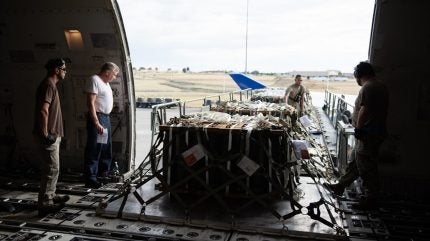GAO says that DoD officials are often unaware of transfers authorised by the State Department until they are identified upon entry to Ukraine, if at all.
John Hill
US Airmen load pallets of ammunition onto a contracted aircraft bound for Ukraine during a security assistance mission at Travis Air Force Base, California, 25 June 2024.
Credit: DVIDS.
The US government is unable to track military supplies transferred to Ukraine by third-party donors due to “inconsistent communication” between departments.
Based on its findings, published on 20 August 2024, the US Government Accountability Office (GAO) has put forward several recommendations to foster information sharing in Washington, thereby allowing the government to identify where US manufactured items are delivered.
The State Department is responsible for authorising third-party transfers (TPTs) of defence articles of US origin. So far, the department has approved 217 cases by more than 26 foreign donors to Ukraine as of April 2024.
The Department of Defense (DoD) is required to conduct end-use monitoring of these items; however, it is limited in its ability to do so.
“DoD officials are often unaware of TPTs authorised by State until they are identified upon entry to Ukraine, if at all,” says the GAO.
See Also:Explainer: prices rise as Ukrainian forces seize key Russian gas hub
Ukraine military situation
Ukrainian President Volodymyr Zelenskyy gave a description of the objectives of the Ukrainian counter-offensive into Kursk, Russia last week.
The US government is unable to track military supplies transferred to Ukraine by third-party donors due to “inconsistent communication” between departments.
Based on its findings, published on 20 August 2024, the US Government Accountability Office (GAO) has put forward several recommendations to foster information sharing in Washington, thereby allowing the government to identify where US manufactured items are delivered.
The State Department is responsible for authorising third-party transfers (TPTs) of defence articles of US origin. So far, the department has approved 217 cases by more than 26 foreign donors to Ukraine as of April 2024.
The Department of Defense (DoD) is required to conduct end-use monitoring of these items; however, it is limited in its ability to do so.
“DoD officials are often unaware of TPTs authorised by State until they are identified upon entry to Ukraine, if at all,” says the GAO.
See Also:Explainer: prices rise as Ukrainian forces seize key Russian gas hub
Ukraine military situation
Ukrainian President Volodymyr Zelenskyy gave a description of the objectives of the Ukrainian counter-offensive into Kursk, Russia last week.
“There have already been several reports by Commander-in-Chief [Ukrainian Col. Gen. Oleksandr] Syrskyi about the frontline situation and our operation in the Kursk region,” Zelenskyy said in his daily report to the Ukrainian people. “We see that the occupier is suffering losses, and this is helpful — very helpful — for our defence. It is about destroying the logistics of the Russian Army and draining their reserves.”
Ukraine’s forces must inflict maximum damage on all Russian positions, he said. The Ukrainian forces are tenaciously defending the Donbas region even as they advance into Kursk. “We are eliminating the Russian military presence in the area of our operations there,” added the head of state.
Impact on timely delivery
The GAO’s recommedations to impose more information sharing processes across government – and additional protocols for TPT countries divesting equipment to Ukraine – may add more time on preparing deliveries to the war-torn nation.
In its report, the GAO noted that the State Department’s document management procedures may not be able to notify the DoD of information on TPT authorisations in a timely manner.
Restructuring intra-govrnmental communciations to allow for this will risk cutting off Ukraine’s armed forces from much-needed equipment when it is most needed, or when it is relevant, at the height of its counter-offensive.
The pace of warfare is ever-changing and Western donors must attempt to deliver at the moment of necessity. We have seen how crucial timely US aid to Ukraine has been at the end of 2023 and beginning of 2024, when Ukrainian forces were forced onto the backfoot after US military assistance froze due to politicking in Washington over that winter period.
At the time, GloblaData Defence Analyst James Marques observed that when deprived of the Western military equipment they needed, Ukraine’s forces “demonstrated a remarkable capacity to manufacture drones, particularly first-person-view variants.
“Such munitions are used to devastating effect in frontline combat, often compensating for Ukraine’s near-constant shortfall in conventional artillery ammunition.”

No comments:
Post a Comment